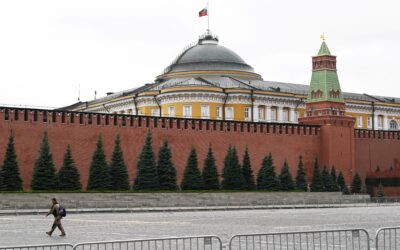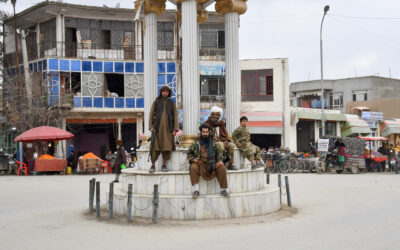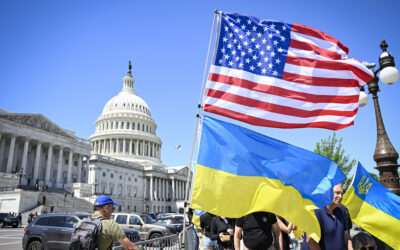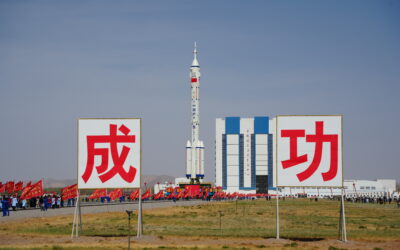
Blindsided by U.S. Ukraine Vote, Kremlin Scrambles to Respond
SUBSCRIBER+ EXCLUSIVE REPORTING — Russia’s reaction to the new infusion of U.S. aid for Ukraine has ranged from shrugs to fury, from warnings of nuclear […] More
OPINION — It’s time for the U.S. to drop denuclearization of the Korean peninsula as its goal and begin to deal with North Korea as a nuclear weapons state, since Kim Jong-un, its leader, has shown no indication that he will ever give them up.
To the contrary – Kim announced on New Year’s Eve, “the importance and necessity of a mass-producing of [more] tactical nuclear weapons and…an exponential increase of the country’s nuclear arsenal.”
South Korea’s relatively new President Yoon Suk Yeol picked up on Kim’s remarks on January 11 when he said, “It’s possible that the [North Korean nuclear weapons] problem gets worse and our country will reintroduce [U.S.] tactical nuclear weapons or build them on our own…If that’s the case, we can have our own nuclear weapons pretty quickly, given our scientific and technological capabilities,” according to a transcript of his remarks released by his office and obtained by The New York Times.
Last Friday, talking to reporters at the Davos Conference, President Yoon backed down a bit and said, “I can assure you that the Republic of Korea’s realistic and rational option is to fully respect the NPT [Non-Proliferation Treaty] regime…I’m fully confident about the U.S.’s extended deterrence.”
Supporting that, on May 21, 2022, in a joint leaders’ statement on the occasion of President Joe Biden’s visit to South Korea, Biden affirmed, “the U.S. extended deterrence commitment to the ROK [Republic of Korea] using the full range of U.S. defense capabilities including nuclear, conventional, and missile defense capabilities.” Presidents Biden and Yoon also agreed to resume the Extended Deterrence Strategy and Consultation Group (EDSCG), a forum for discussing diplomatic, economic, informational, and military coordination to deter threats to the alliance.
The Biden administration’s 2022 Nuclear Posture Review (NPR) recognized that North Korea “poses a persistent threat and growing danger to the U.S. homeland and the Indo-Pacific region as it expands, diversifies, and improves its nuclear, ballistic missile, and non-nuclear capabilities… A crisis or conflict on the Korean Peninsula could involve a number of nuclear-armed actors, raising the risk of broader conflict.”
The Biden NPR goes on to describe “our strategy for North Korea” was “to make clear to the Kim regime, the dire consequences should it use nuclear weapons. Any nuclear attack by North Korea against the United States or its Allies and partners is unacceptable and will result in the end of that regime. There is no scenario in which the Kim regime could employ nuclear weapons and survive.”
Beyond that threat, the Biden administration strategy appears to be in a waiting game — that the U.S. would meet with North Korean officials without preconditions to talk over both nuclear and non-nuclear issues. So far, there has been no publicly-known response from Pyongyang, other than multiple tests of North Korean ballistic missiles and threat of a new nuclear test.
Meanwhile, earlier this month, U.S. and South Korean officials met to talk about joint planning with conventional forces for the Korean Peninsula in the face of the North Korean threat.
I doubt most Americans know that North Korea’s possession and potential use of nuclear weapons are built into the country’s law, first by an act passed by its Supreme People’s Assembly back in 2013 and amended last year, on September 8, 2022.
Subscriber+Members have a higher level of access to Cipher Brief Expert Perspectives. Find out what you’re missing. Upgrade your access to Subscriber+ now.
The law describes North Korea as “a responsible nuclear weapons state” that “opposes all forms of wars including nuclear war.” The law also says North Korea’s nuclear weapons are “a main force of the state defense which safeguards the sovereignty and territorial integrity of the country and the lives and safety of the people from outside military threat, aggression and attack.”
As amended last September, the law now lists cases when North Korea could use its nuclear weapons: Among them are when North Korea is attacked by an enemy’s nuclear weapons; when a hostile non-nuclear attack is made against North Korea’s state leadership and the country’s nuclear forces; and when a catastrophic crisis threatens the existence of the state and the safety of its people.
When the law was amended last September, Kim told the People’s Assembly, “The utmost significance of legislating nuclear weapons policy is to draw an irretrievable line so that there can be no bargaining over our nuclear weapons.” According to Reuters, he added that he would never surrender the weapons even if the country faced 100 years of sanctions.
This past week, the Washington-based Center for Strategic and International Studies (CSIS) released a study titled, North Korean Policy and Extended Deterrence in which it claims “shifts in the strategic landscape call for the United States and its allies to reexamine traditional approaches to the North Korea nuclear issue and devise ways to increase the credibility of U.S. extended deterrence.”
The CSIS study specifically says, “The allies should not consider the re-deployment of U.S. tactical nuclear weapons to the Korean peninsula, or the acquisition of nuclear weapons by South Korea under current circumstances.”
However, it not only recommends, “Resume U.S.-ROK joint military exercises that were suspended or downgraded in previous negotiations,” but also calls for reconsideration of exercises that “lay pre-decisional groundwork for possible redeployment of U.S. low-yield nuclear weapons.”
In addition, the CSIS study calls for creation of “a framework for joint nuclear planning…similar to a NATO planning group for nuclear weapons use, with planning conducted bilaterally and trilaterally (with Japan) and control remaining in the hands of the United States.”
It also suggests sending a senior South Korean liaison officer to U.S. Strategic Command and reviving the Blue Lightning exercises, which involved the deployment of B-52H or B-1B strategic, nuclear-capable bombers from the U.S. Air Force’s Andersen Base in Guam to the Korean Peninsula. Fighters from South Korea, the U.S. and Japan were also mobilized to escort the long-range bombers.
A new book published this month, provides a serious study of how North Korea – over almost 40 years – has followed two paths — nuclearization and diplomacy. Hinge Points: An Inside Look at North Korea’s Nuclear Program, was written by Siegfried S. Hecker, a former head of Los Alamos National Laboratory and currently a senior fellow and professor emeritus at Stanford University. Between 2004 and 2010, Hecker made yearly visits to North Korea and visited its nuclear facilities.
Hecker writes that the U.S. has “had a singular focus on denuclearization,” while three North Korean leaders have chosen “to pursue diplomacy plus nuclearization, not one or the other,” in order to “hedge against failure in one track or the other and mitigate the risks inherent in the vicissitudes of the post–Cold War international system and its own authoritarian domestic politics.”
“While the North has slowed its nuclear progress at times, it has never fully abandoned the nuclear track,” Hecker writes. At the same time, Washington, he says, “failed to deal with Pyongyang’s dual-track strategy, missing key opportunities for diplomacy and misinterpreting some of the North’s actions, which led to bad decisions.”
Hecker said former-President Trump’s threatening Kim with “fire and fury,” resulted in the North Korean leader putting “his nuclear and missile programs into high gear, achieving both hydrogen bomb capability and ICBM missiles much sooner than anyone had predicted. Kim ended the year [2017] by indicating that he had completed his nuclear force.”
Doing a 180-degree turn, Trump, according to Hecker, “sent a secret message via a U.N. official to Kim that he was willing to meet.”
The resultant June 2018, U.S.-North Korea, Trump-Kim Summit in Singapore, produced what Hecker described as “a short but important joint statement pledging to pursue denuclearization and normalization of relations…I viewed it as a critical step in the right direction.”
However, Hecker says, Trump’s National Security Advisor John Bolton at the Hanoi Summit in February 2019, “convinced Trump that it was better for him to walk away unless the North totally capitulated its nuclear program…Kim returned home angry and disillusioned. Trump continued to hope for a deal, but Kim expressed his utter disappointment in personal letters to Trump.”
I assume these are among the letters that Trump attempted to keep and eventually were turned over to the National Archives.
In any event, Hecker marks the Hanoi Summit along with events in the George W. Bush and Obama administrations as “hinge points” in Washington-Pyongyang nuclear relations.
I would add one more historic moment – or hinge point — that needs recalling when talking about North Korea’s long-term desire to become a nuclear power.
It was the Eisenhower administration in 1958, that first sent atomic weapons into South Korea, breaking a provision of the 1953 Korean Armistice Agreement, which barred the introduction on either side, of “new” weapons, which included nuclear ones. Then-President Eisenhower wanted to reduce defense spending by removing some American troops from South Korea and the Joint Chiefs would only agree if the departing forces were replaced by nuclear weapons. At the time, the U.S. tried to justify its action by saying Russia had supplied North Korea with MIG aircraft that were capable of carrying nuclear bombs, but no such bombs were supplied.
By the mid-1960s, the U.S. had more than 900 nuclear artillery shells, nuclear tactical bombs, and other nuclear weapons in South Korea and the North Koreans had none. Although all U.S. nuclear weapons were removed from South Korea in 1991, the desire for North Korea to have its own nuclear weapons remained for Kim Jong-un — as it had for his father and grandfather.
Today’s situation is not quite the reverse. The U.S. nuclear umbrella still covers South Korea, and if events now in planning take place, that umbrella will be more apparent in the future.
Meanwhile, the U.S. and four original nuclear powers – Russia, England, France and China – have learned to live with nuclear-armed India, Israel and Pakistan. I believe today’s facts mean that North Korea is part of that latter group — like it or not.
Read more expert-driven national security insights, perspective and analysis in The Cipher Brief
Related Articles

SUBSCRIBER+ EXCLUSIVE REPORTING — Russia’s reaction to the new infusion of U.S. aid for Ukraine has ranged from shrugs to fury, from warnings of nuclear […] More

SUBSCRIBER+ EXCLUSIVE REPORTING — When Chinese President Xi Jinping came to San Francisco last November to meet with President Joe Biden, Chinese pro-democracy activists in […] More

SUBSCRIBER+EXCLUSIVE EXPERT PERSPECTIVE — More than two years after its withdrawal from Afghanistan, the U.S. still does not have a clear way forward in the […] More

SUBSCRIBER+ EXCLUSIVE REPORTING — Ukrainians greeted Saturday’s long-awaited House passage of $60.8 billion in aid with justifiable jubilation. For months, their soldiers, civilians, and political […] More

SUBSCRIBER+ EXCLUSIVE REPORTING — A race for control of space is underway, and just as on earth, the U.S. and China are the top competitors. […] More

SUBSCRIBER+ EXCLUSIVE REPORTING — For nearly a week, the Middle East and much of the world were on a knife’s edge, waiting for a promised […] More
Search